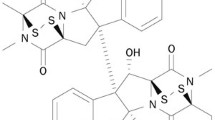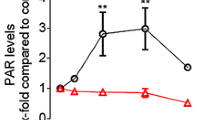Abstract
Bisnaphthalimido compounds bis-intercalate to DNA via the major groove and are potentially potent cancer therapeutics. Previously, we incorporated natural polyamines as linkers connecting the two naphthalimido ring moieties to create a series of soluble bisnaphthalimidopropyl polyamines (BNIPPs). Here, extending earlier work on bisnaphthalimidopropylspermidine (BNIPSpd)-induced apoptosis in colon adenocarcinoma Caco-2 cells, we compare the cytotoxicity and genotoxicity of BNIPSpd relative to the spermine and oxaspermine derivatives, bisnaphthalimidopropylspermine (BNIPSpm) and bisnaphthalimidopropyloxaspermine (BNIPOSpm). The order of cytotoxicity after 24 h was BNIPSpd (IC50 = 0.47 μM) > BNIPSpm (IC50 = 10.04 μM) > BNIPOSpm (IC50 >50 μM). After a 72-h BNIPOSpm exposure, an IC50 = 10.25 μM was achieved. With 4-h exposure to BNIPSpd or BNIPSpm or 12-h exposure to BNIPOSpm, concentrations ≥1 μM induced a significant dose-dependent increase in DNA damage as measured by alkaline single-cell gel electrophoresis. The longer incubation times required for BNIPOSpm to induce DNA strand breaks reflect a slower rate of BNIPOSpm cellular distribution as monitored via BNIPP fluorescence within the cells. Moreover, exposure to a non-genotoxic concentration of BNIPSpd, BNIPSpm (0.1 μM for 4 h) or BNIPOSpm (0.1 μM for 12 h) induced a significant decrease in repair of oxidative DNA damage induced by hydrogen peroxide. In conclusion, BNIPP exposure in Caco-2 cells is associated with significant induction of DNA damage and inhibition of DNA repair at non-genotoxic concentrations. The latter is a novel consequence of BNIPP–cell interactions which adds to the spectrum of therapeutically relevant activities that may be exploited for the design and development of naphthalimide-based therapeutics.







Similar content being viewed by others
Abbreviations
- BNIPSpd:
-
Bisnaphthalimidopropylspermidine
- BNIPSpm:
-
Bisnaphthalimidopropylspermine
- BNIPOSpm:
-
Bisnaphthalimidopropyloxaspermine
- SCGE:
-
Single-cell gel electrophoresis
References
Abad A, Gravalos C, Font A, Molina F, Diaz-Puente MT, Fabregat X, et al. Phase II study of mitonafide in advanced and relapsed colorectal cancer. Invest New Drugs. 1996;14:223–5.
Antonini I, Volpini R, Dal Ben D, Lambertucci C, Cristalli G. Design, synthesis, and biological evaluation of new mitonafide derivatives as potential antitumor drugs. Bioorg Med Chem. 2008;16:8440–6.
Bailly C, Carrasco C, Joubert A, Bal C, Wattez N, Hildenbrand MP, et al. Chromophore-modified bisnaphthalimides: DNA recognition, topoisomerase inhibition, and cytotoxic properties of two mono- and bisfuronaphthalimides. Biochemistry. 2003;42:4136–50.
Basuroy UK, Gerner EW. Emerging concepts in targeting the polyamine metabolic pathway in epithelial cancer chemoprevention and chemotherapy. J Biochem. 2006;139:27–33.
Brana MF, Ramos A. Naphthalimides as anti-cancer agents: synthesis and biological activity. Curr Med Chem Anti-Canc Agents. 2001;1:237–55.
Brana MF, Castellano JM, Moran M, Perez de Vega MJ, Romerdahl CR, Qian XD, Bousquet PF, Emling F, Schlick E, Keilhauer G. Bis-naphthalimides: A new class of antitumor agents. Anticancer Drug Des. 1993;8:257–268.
Brana MF, Cacho M, Gradillas A, de Pascual-Teresa B, Ramos A. Intercalators as anticancer drugs. Curr Pharm Des. 2001;7:1745–80.
Brana MF, Cacho M, Ramos A, Dominguez MT, Pozuelo JM, Abradelo C, et al. Synthesis, biological evaluation and DNA binding properties of novel mono and bisnaphthalimides. Org Biomol Chem. 2003;1:648–54.
Brana MF, Cacho M, Garcia MA, de Pascual-Teresa B, Ramos A, Dominguez MT, et al. New analogues of amonafide and elinafide, containing aromatic heterocycles: synthesis, antitumor activity, molecular modeling, and DNA binding properties. J Med Chem. 2004a;47:1391–9.
Brana MF, Gradillas A, Gomez A, Acero N, Llinares F, Munoz-Mingarro D, et al. Synthesis, biological activity, and quantitative structure-activity relationship study of azanaphthalimide and arylnaphthalimide derivatives. J Med Chem. 2004b;47:2236–42.
Casado A, Rosell R, Garcia-Gomez R, Diaz-Rubio E, Perez-Manga G, Font A, et al. Phase II study of mitonafide in non-small cell lung cancer (NSCLC). Invest New Drugs. 1996;14:415–7.
Chen Z, Liang X, Zhang HY, Xie H, Liu J, Xu Y, et al. A new class of naphthalimide-based antitumor agents that inhibit topoisomerase II and induce lysosomal membrane permeabilization and apoptosis. J Med Chem. 2010;53:2589–600.
Collins A, Ma A, Duthie SJ. The kinetics of repair of oxidative DNA damage (strand breaks and oxidised pyrimidines) in human cells. Mutat Res. 1995;336:69–77.
Costanza ME, Berry D, Henderson IC, Ratain MJ, Wu K, Shapiro C, et al. Amonafide: an active agent in the treatment of previously untreated advanced breast cancer—a cancer and leukemia group B study (CALGB 8642). Clin Cancer Res. 1995;1:699–704.
Dance AM, Ralton L, Fuller Z, Milne L, Duthie SJ, Bestwick CS, et al. Synthesis and biological activities of bisnaphthalimido polyamines derivatives: cytotoxicity, DNA binding, DNA damage and drug localization in breast cancer MCF 7 cells. Biochem Pharmacol. 2005;69:19–27.
Duthie SJ, Ma A, Ross M, Collins A. Antioxidant supplementation decreases oxidative DNA damage in human lymphocytes. Cancer Res. 1996;56:1291–5.
Duthie SJ, Mavrommatis Y, Rucklidge G, Reid M, Duncan G, Moyer MP, et al. The response of human colonocytes to folate deficiency in vitro: functional and proteomic analyses. J Proteome Res. 2008;7:3254–66.
Filosa R, Peduto A, Di Micco S, De Caprariis P, Festa M, Petrella A, et al. Molecular modelling studies, synthesis and biological activity of a series of novel bisnaphthalimides and their development as new DNA topoisomerase II inhibitors. Bioorg Med Chem. 2009;17:13–24.
Hansen WK, Kelley MR. Review of mammalian DNA repair and translational implications. J Pharmacol Exp Ther. 2000;295:1–9.
Hoskins C, Ouaissi M, Costa Lima S, Ping Cheng W, Loureirio I, Mas E, et al. In vitro and in vivo anticancer activity of a novel nano-sized formulation based on self-assembling polymers against pancreatic cancer. Pharm Res. 2010;27:2694–703.
Hsiang YH, Jiang JB, Liu LF. Topoisomerase II-mediated DNA cleavage by amonafide and its structural analogues. Mol Pharmacol. 1989;36:371–6.
Johansson VM, Oredsson SM, Alm K. Polyamine depletion with two different polyamine analogues causes DNA damage in human breast cancer cell lines. DNA Cell Biol. 2008;27:511–6.
Kong Thoo Lin P, Pavlov VA. The synthesis and in vitro cytotoxic studies of novel bis-naphthalimidopropyl polyamine derivatives. Bioorg Med Chem Lett. 2000;10:1609–12.
Kong Thoo Lin P, Dance AM, Bestwick CS, Milne L. The biological activities of new polyamine derivatives as potential therapeutic agents. Biochem Soc Trans. 2003;31:407–10.
Lv M, Xu H. Overview of naphthalimide analogs as anticancer agents. Curr Med Chem. 2009;16:4797–813.
Menzel TM, Tischer M, Francois P, Nickel J, Schrenzel J, Bruhn H, et al. Mode-of-action studies of the novel bisquaternary bisnaphthalimide MT02. Antimicrob Agents Chemother. 2011;55:311–20.
Mijatovic T, Mahieu T, Bruyere C, Neve ND, Dewelle J, Simon G, et al. UNBS5162, a novel naphthalimide that decreases CXCL chemokine expression in experimental prostate cancers. Neoplasia. 2008;10:573–86.
Mosmann T. Rapid colorimetric assay for cellular growth and survival: application to proliferation and cytotoxicity assays. J Immunol Methods. 1983;65:55–63.
Oliveira J, Ralton L, Tavares J, Codeiro-da-Silva A, Bestwick CS, McPherson A, et al. The synthesis and the in vitro cytotoxicity studies of bisnaphthalimidopropyl polyamine derivatives against colon cancer cells and parasite Leishmania infantum. Bioorg Med Chem. 2007;15:541–5.
Ralton LD, Bestwick CS, Milne L, Duthie S, Kong Thoo Lin P. Bisnaphthalimidopropyl spermidine induces apoptosis within colon carcinoma cells. Chem Biol Interact. 2009;177:1–6.
Schipper RG, Penning LC, Verhofstad AA. Involvement of polyamines in apoptosis. Facts and controversies: effectors or protectors? Semin Cancer Biol. 2000;10:55–68.
Singh N, McCoy M, Tice R, Schneider E. A simple technique for quantitation of low levels of DNA damage in individual cells. Exp Cell Res. 1988;175:184–91.
Tian ZY, Xie SQ, Mei ZH, Zhao J, Gao WY, Wang CJ. Synthesis, cytotoxicity and apoptosis of naphthalimide polyamine conjugates as antitumor agents. Eur J Med Chem. 2009;44:393–9.
Van Quaquebeke E, Mahieu T, Mijatovic T, Dewelle J, Van Vynckt F, Darro F, et al. 2,2,2-Trichloro-N-({2-[2-(dimethylamino)ethyl]-1,3-dioxo-2,3-dihydro-1H-benzo[de]isoquinolin-5-yl}carbamoyl)acetamide (UNBS3157), a novel non-hematotoxic naphthalimide derivative with potent anti-tumor activity. Mol Cancer Ther. 2007;12:3420S–1S.
Villalona-Calero MA, Eder JP, Toppmeyer DL, Allen LF, Fram R, Velagapudi R, et al. Phase I and pharmacokinetic study of LU79553, a DNA intercalating bisnaphthalimide, in patients with solid malignancies. J Clin Oncol. 2001;19:857–69.
Yang L, Li W, Tian Z, Zhao J, Wang C. Mononaphthalimide spermidine conjugate induces cell proliferation inhibition and apoptosis in HeLa cells. Toxicology in Vitro. 2011;25:882–89.
Zhu H, Miao ZH, Huang M, Feng J-M, Zhang Z-X, Lu J-J, et al. Naphthalimides induce G(2) arrest through the ATM-activated Chk2-executed pathway in HCT116 cells. Neoplasia. 2009;11:1226–34.
Acknowledgements
This work was supported by the School of Pharmacy and Life Sciences, The Robert Gordon University Aberdeen and by the Scottish Government (RINH).
Author information
Authors and Affiliations
Corresponding author
Rights and permissions
About this article
Cite this article
Bestwick, C.S., Ralton, L.D., Milne, L. et al. The influence of bisnaphthalimidopropyl polyamines on DNA instability and repair in Caco-2 colon epithelial cells. Cell Biol Toxicol 27, 455–463 (2011). https://doi.org/10.1007/s10565-011-9199-1
Received:
Accepted:
Published:
Issue Date:
DOI: https://doi.org/10.1007/s10565-011-9199-1




